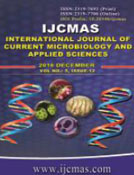


 National Academy of Agricultural Sciences (NAAS)
National Academy of Agricultural Sciences (NAAS)

|
PRINT ISSN : 2319-7692
Online ISSN : 2319-7706 Issues : 12 per year Publisher : Excellent Publishers Email : editorijcmas@gmail.com / submit@ijcmas.com Editor-in-chief: Dr.M.Prakash Index Copernicus ICV 2018: 95.39 NAAS RATING 2020: 5.38 |
Acinetobacter species is emerging as a major cause of nosocomial and community acquired infections. To study the resistance pattern of Acinetobacter species. The study was carried out in the Department of Microbiology, Navodaya Medical College, Raichur from December 2013 to November 2014. Out of 5255 clinical samples processed, Acinetobacter species was identified by standard microbiological methods. Modified Kirby Bauer method was used for testing the sensitivity of Acinetobacter species against 11 antimicrobial drugs as per the CLSI guidelines 2011. 72(4%) revealed Acinetobacter species out of total 1786 (34%) culture positives. Isolation was maximum in pus (47%), followed by sputum(17%), urine(14%), blood(12%), CSF(10%). The sensitivity pattern of Acinetobacter species in this study shows maximum sensitivity to Meropenem (86%), followed by Piperacillin Tazobactam (76%), Amiakacin (67%), Ampicillin Sulbactum(58 %), Gentamicin (50%), Ciprofloxacin (49%), Ceftazidime (40%), Tetracycline (31%), Cotrimoxazole (29%), Ceftriaxone (21%) and Cefepime (18%). Development of resistance to commonly used antibiotics has lead to difficulty in treatment of Acinetobacter infections. This type of hospital based data might help to improve the knowledge of antibiotic resistance patterns in this region.
 |
 |
 |
 |
 |